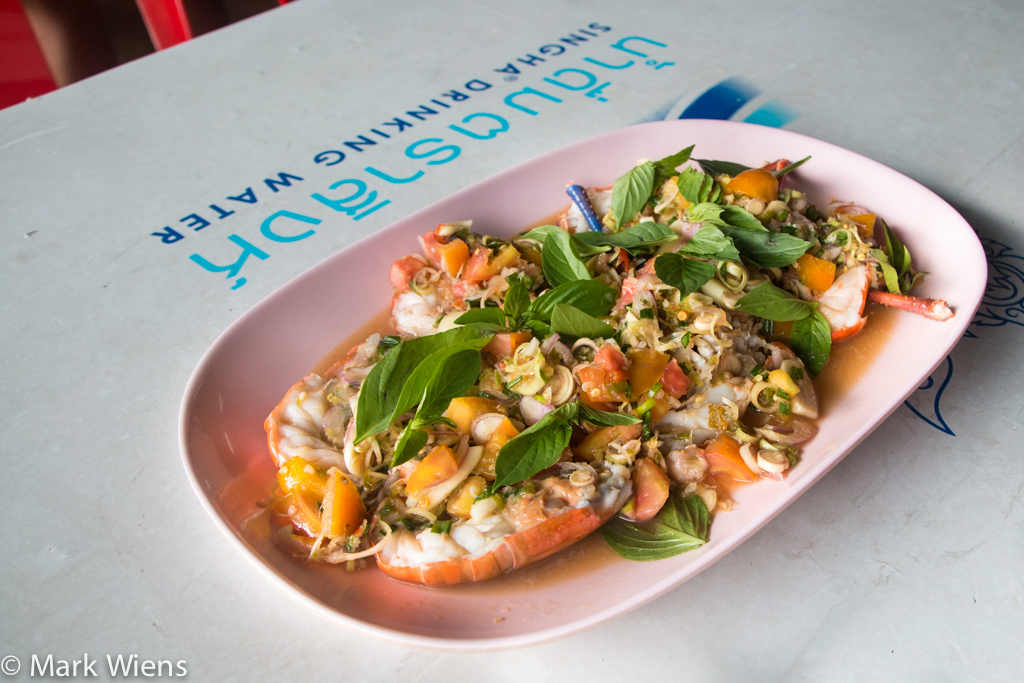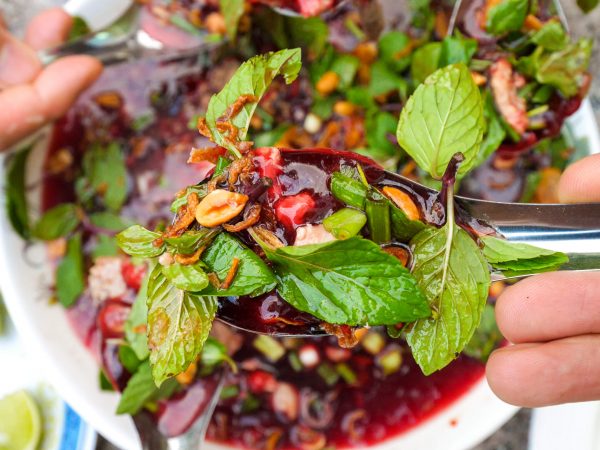

About two months ago I received an email (in Thailand)…
It went something along the lines of this:
“Hi Mark Wiens, we’ve seen your YouTube videos, and we like how you express your passion for food. We’re producing a food tv show documentary about Thai food, and we’d like you to be part of it.”
At first I didn’t know what “part of it” meant, so I asked for more information.
A few emails later, I realized the production company was asking if I’d be a host for a Thai food tv show.
Traveling around Thailand and eating delicious Thai food, is something I love doing, and something I already do, and so I agreed to be part of the show.
After a few months of the production company arranging all the details, and just 1 meeting with the producers and the entire crew, we were ready to get started.

One of the things that enticed me about this particular tv show, was that they showed me some examples of what we’d be filming, and it was about real Thai food, not touristy toned down Thai food, but real Thai food.
We’d travel around Thailand searching for some of the best tasting Thai dishes, things you shouldn’t miss eating when in Thailand.
Food TV Show
I’m quite excited to announce to you that for the next two months or so, I’ll be traveling around Thailand, filming a Thai food documentary show (I’m still not sure where it will be shown, but it’s some Thai cable station).
It’s my first time to ever do something like this, the only person I’ve stood in front of the camera for so far is my wife – so it will be a little different this time.
I know it will be a great learning experience, and an adventure.
(NOTE: I’ll still posting videos to YouTube on schedule as normal during this time)
What can you expect from me?
During the next few months, while I’m traveling around Thailand, I’ll be posting frequent blog updates, probably not daily, but every couple of days I’ll try to post some photos and an overview of what we did and ate.
As I write this update, we just finished filming two days of the food show, and it’s been quite a packed two days already.

Day 1: Silom, Bangkok
The first episode of the food show is about Thai salads, known in Thai as yam (ยำ).
We started the very first episode at the food court in Silom Soi 10. The funny thing is, Ying and I had just filmed a video about the Silom Soi 10 food court a few weeks before (I had no clue we were going again for the show).
At the beginning of the food section of the Silom Soi 10 food court, there’s a famous Thai salad stall, which attracts quite a line each day for lunch.
Get exclusive updates
Enter your email and I’ll send you the best travel food content.

For the show, we ordered yam woon sen (ยำวุ้นเส้น), a very popular Thai mix salad, and also yam hed (ยำเห็ด), Thai mushroom salad.
They were both quite good, the dressing was nice and sour and spicy, but I’m not a huge fan of luncheon meat and hot dogs. I mostly prefer my yum woon sen with more natural meats, like minced pork, as opposed to tube steak.

After polishing off the salads and completing the footage at the food court, we headed off to Thanon Chan to go to another famous food stall serving Thai salads.
The owner of the restaurant was extremely nice, and she allowed me to cook with her and talk to her about all sorts of different ingredients in the different salads that she was whipping up furiously.

After filming the salad preparation, the crew proceeded to order a whopping 10 different Thai salads for me to eat on camera.
Pictured above in yam mamuang (ยำมะม่วง), a green mango salad with shrimp, onions, peanuts, and cilantro, all dressed in a spicy lime and chili sauce.

Out of all the 10 different Thai salads, my favorite was the yam pla meuk (ยำปลาหมึก), a squid salad.
The squid was blanched, and then mixed up with white onions, mint leaves, and a dressing of lots of lime juice, chilies, and just a hint of sugar to balance it out . It was marvelous.

Day 2: Vegetable Farm in Bang Khae, Bangkok
Bang Khae is a district, located about 45 minutes to 1 hour from central Bangkok, and the area is home to the Khlong Lay Mayom floating market as well.

We woke up really early on day 2, and took a van out to Bang Khae, and to continue on with the Thai salads theme, we headed to a small organic vegetable farm.

We arrived just as the sun was rising, and a few farmers were already tending to the crops.
The goal for visiting the farm was to mainly walk around and see some of the main local herbs and ingredients used in popular and traditional Thai salad recipes.

There’s a term in Thai known as pak suan krua (ผักสวนครัว). There’s no direct translation, but it sort of means easy to grow, everyday types of vegetables.
Things like basil, lemongrass, chilies, ivy gourd leaves, long beans, and a number of other vines and herbs can be included.

Eating raw vegetables and herbs, like chilies, sweet basil, lemongrass, and even traditionally winged beans (ถั่วพลู), are just a few of the many small vegetables that were thriving in this garden.

One of the highlights of my morning was walking around the garden, sampling marvelous herbs right off the vines and bushes, with one of the owners of the farm.

Among the many herbs I ate (by the end of my herb eating session, my mouth was tingling from all the peppery fresh herbs), one of my favorites was red holy basil (ใบกระเพราแดง).
Normal holy basil, used in making pad kra pao, is found in every market in Bangkok, but the red stuff is very hard to find. It has a slightly stronger flavor than its green sibling.

Another herb I hadn’t eaten before, but got to eat handfuls of, was bai yeera (ใบยี่หร่า), or jeera leaves.
It had an amazing strong herb flavor, and the lady told me it was especially delicious stir fried up with wild pig. My mouth started watering immediately, but too bad we didn’t have any wild pig on hand.

After spending a while eating a huge amount of herbs in the garden, I was able to hang out for a bit with a man, who taught me how to pick a few of the essential Thai vegetables.
One of the vegetables he was harvesting, he called watercress, and it’s not common at Thai markets, but I do see it in grocery stores in the organic section.
The watercress was just slightly bitter, but had a lovely green healthy flavor.

One of the most common Thai vegetables is pak bung (ผักบุ้ง), or Thai morning glory.
I’ve eaten uncountable plates of morning glory at hundreds of restaurants throughout Thailand, but I can’t say I’ve ever seen it being grown, and for sure I had never harvested it myself.

To grow morning glory, it takes a lot of water.
At the farm, they water the morning glory using sticks that look quite a bit like lacrosse sticks, and just sort of fling water from the canal ditches across the plot of morning glory.

Normally after picking their stock of morning glory, they sell it at the local nearby market.
They kindly gave us a bundle of fresh morning glory to bring home, which I was extremely grateful for.

After filming the herb and vegetable gardens, we then headed under the shelter to do some filming about making a Thai salad using some of the ingredients I had just freshly picked.
For dressing, Thai salad mostly uses lime juice, fish sauce, chilies, and a hint of sugar. This is the balance of flavors that Thai food is so well known for.

I mixed up some of the vegetables and herbs into a healthy Thai salad that was quite complex with different herbs. I used quite a generous amount of red holy basil to give it a serious kick.
I couldn’t get enough of that red holy basil (ใบกระเพราแดง).

During the day at the farm, I got to hang out with Grandma, who was awesome.

After finishing up at the farm, we had a quick lunch, and then headed over to a restaurant known as Ran Soei (ร้านเส่ย), a place I had never been to, but I can assure you I will be going back.
The restaurant was located right at the Sam Sen railway station, quite close to the glories of Ratchawat and Gaeng Pa Sriyan.

We went to the restaurant to prepare and eat a Thai salad known as plaa goong (พล่ากุ้ง).
I stood with the owner’s wife as she whipped up the combination of ingredients, and I watched in awe at the creation.
She mixed up a sauce, full of wonderful herbs and flavors, and then piled it onto half cooked shrimp, which were already butterfly cut.

I’ve had plaa goong (พล่ากุ้ง) quite a few times in Bangkok, but it has never even compared to the version at Ran Soei (ร้านเส่ย).
The jumbo prawns were meaty and buttery, and drenched in an extremely sour and spicy dressing, then covered in chilies, raw garlic, and slices of lemongrass.

Finally, to round out our second day of filming, we also had a few plates of gaem pla too (แก้มปลาทู), or what translates to deep fried mackerel cheeks – but really they were more like mackerel jaw bones.
They were incredibly crispy, like a fish chip, and absolutely amazing tasting.
Conclusion
Again, I’m really excited and honored to be a part of this Thai food tv show.
We’ve only filmed for two days so far, and already I’ve had some very fun and unique food experiences.
Along with keeping you updated with a blog post every couple of days, I’ll also be posting current updates and photos on Facebook and Instagram.
This is something totally new for me, I’m grateful for this opportunity, and I’m pretty excited about the filming, and especially the EATING!
That’s it for now, I’ll keep you posted, and thank you for your continued support.
Get exclusive updates
Enter your email and I'll send you the best travel food content.



